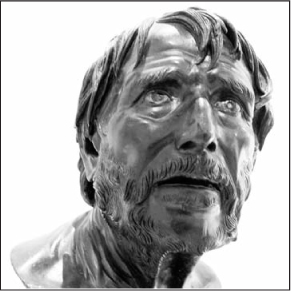Cycladic, Minoan, Mycenaean, and Archaic Greek MythologyHesiod, the Greek Creation Myth, Wars Among the Gods |
What was Hesiod’s creation myth? |
Hesiod tells how the first activity in what was a chaos-based creation was the emergence of nothingness itself—Chaos (the Void). Out of Chaos came “wide-bosomed Earth,” known to us as the great goddess Gaia.
The beautiful Eros (Desire) came next, the necessary element in a process that would lead to the procreation of the universe and the gods. Eros, says Hesiod, can undermine the more controlled intentions of the mind, a phenomenon with which most of us are familiar. Darkness and Night also came out of the Void. Then followed the first mating: Darkness was drawn in love to Night and the result was Night’s giving birth to Light and Day. Now Gaia produced Sky (Uranos) out of herself, large enough to “cover her” completely in the act of constant procreation that reminds us of the joining of An and Ki in Mesopotamia and Geb and Nut in Egypt. Out of this joining— “without the urging of love”—Gaia gave birth to the mountains, the places loved by the gods, the rivers and lakes and the oceans (Oceanos). The next set of offspring was made up of the Earth goddess Rhea, Themis (Law), Mnemosyne (Memory), Tethys (sea goddess), Phoebe (Moon), and finally, Kronos and several monstrous figures such as the Cyclops. These children of Gaia and Uranos were known as the Titans, the first generation of gods.
Gaia had no love for Uranos or his violent treatment of her children. As each one was born, Uranos forced it back into Mother Earth, causing her great pain. As in the case of the Sumerian and Egyptian copulating creation deities, it became clear that separation was necessary if creation itself was to be realized. It was Gaia herself who devised the solution. She created a huge sickle and challenged her children to use it on their father. Only Kronos was bold enough to take up the task and to listen to his mother’s plan. When night came and Sky as usual covered Earth, Kronos was waiting with the sickle, and he sliced off his father’s genitals and hurled them into the sea. Gaia absorbed the drops of blood that came from the wound and through them gave birth to the Furies (Erinyes) and the Giants. Out of the genitals flowing in the oceans came a foamlike fluid, out of which sprang a beautiful girl, the Goddess of Love, Aphrodite.
Meanwhile Destruction, Death, Blame, Grief, Retribution, Old Age, and other horrors were born of Night.
After mating with the Sea, Gaia gave birth to many strange beings, including Phorcys and Keto. They, in turn, produced the monstrous Gorgons. Among these sisters was Medusa, whose hair was to become a nest of snakes.
Gaia’s daughter Rhea mated with Kronos and gave birth to several famous offspring, including Hestia, Demeter, Hera, Hades, Poseidon, and Zeus, who would later be known, with some of Zeus’s children, as the Olympians, because they would live on Mount Olympus. But Kronos had inherited his father Uranos’s evil ways, and fearing that, as prophesied by Gaia and Uranos, one of his own children might displace him as king, he swallowed each one as it was born. And, as did her mother, Rhea undermined her husband’s wicked policy. Helped by Gaia and Uranos, she fled to Crete, where she gave birth to Zeus and hid him in a cave deep in her mother, Earth. She swaddled a huge stone and presented the false baby to Kronos, who immediately swallowed it. When Kronos vomited the stone, Zeus came to free his brothers and sisters. He also freed the brothers of Kronos, whom Uranos had imprisoned in Mother Earth. These uncles gave Zeus the gift of the thunderbolt, which solidified his ultimate power over men and gods.

A bronze bust portays the Greek poet Hesiod.
